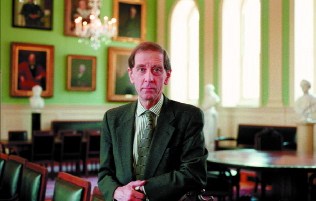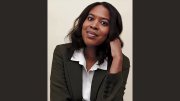Early in that decade-plus-one, Knowles addressed persistent deficits that would, over time, have sapped the faculty's strength. As means became available, he made necessary investments in FAS's neglected infrastructure. And then, buttressed by support from faculty members and alumni, he pursued a select list of enhancements to the research and teaching conducted within what he came to call a "community of scholars." Those gains accelerated courtesy of the University Campaignwhich brought FAS $1.2 billion in gifts and pledgesand the unprecedented growth of the endowment in the late 1990s.
But such blessings were never inevitable. In retrospect, it is clear that the disciplined trajectory Knowles established put FAS in a strong position to bolster its professorial ranks to take on the intellectual challenges of the new century.
The hand Knowles was dealt was unpromising. When economist A. Michael Spence resigned as dean in 1990 to take the reins at Stanford's business school, he left behind both a formidable list of needs (dozens of new faculty positions, huge capital projects like renovating the freshman dormitories in Harvard Yard) and an annual operating deficit of some $12 millionnearly 5 percent of FAS's budget. Even a stern diet imposed by Henry Rosovsky in his one year as acting dean left FAS with a deficit of nearly $10 million.
 |
| Jeremy R. Knowles in the Faculty Room of University Hall, which was meticulously renovated during his 11 years of service as dean. |
| Photograph by Justin Ide / Harvard News Office |
Why then did Knowleswho had turned down entreaties to become dean in 1984, succeeding Rosovskyaccept this time, during a recession, with costs to cut, on the eve of a massive fundraising effort? For one thing, Knowles, who was and is Houghton professor of chemistry and biochemistry, had by then had nearly a decade more of highly successful research and teaching, and was mindful, he said, that "Scientists tend not to grow wise. There is a fierce quality in this institution, and one would never want to be A-." So the second offer of the deanshipa surprise, in light of his earlier reluctanceappeared as an attractive opportunity to do "something very, very different." That the offer came from Rudenstine, a new president and almost an exact contemporary, made the proposition seem "an exciting, an invigorating and energizing new set of challenges to look atand that proved correct."
Blissful ignorance also played a part. Did he grasp the faculty's fiscal hole, and what filling it would require? "No," the self-possessed dean now admits.
"By the end of the summer [of 1991], I more or less understood the problem" of the "deep-seated" deficits, he continues. A visit to each department "to see how they lived was vastly illuminating," too. From that came the conviction that "even though bankrupt," the faculty had to bring together its humanities scholars, who were dispersed haphazardly throughout and beyond Harvard Yard. "There was not even the opportunity for a community," he says. "If one only ever sees one's colleagues across the departmental meeting table, and one's students the other side of a podium, there isn't much community there." Thus were established the themes of a deanship: frugality, faithfulness to the core purposes of scholarship, and bootstrapping resources to sustain them.
His first decanal letter to the faculty, in January 1992, was spinach. Knowles the scientist resorted to charts and graphs (making this the first illustrated letter) to help Knowles the teacher drive home the lesson that the financial news was "not reassuring." The dean, who loves humorous literary allusions, and has indulged in them freely in recent annual letters, then allowed himself only one ("We must recognize that we are somewhat worse off than the Red Queen, who ran as fast as she could to stay in the same place")pointedly aimed at setting the stage for a period in which "the best treatment...should be manageable, although not painless."
Those measures included eliminating several dozen administrative and support jobs and restraining departmental budgetsthe behavior, as he put it in late 1992, of a "wet-weather dean." Reporting in 1994, when the deficit had been halved, Knowles noted continuing "moderation in the growth of student financial aid" as a contributing factor. Even as the University Campaign gathered $500 million in gifts and pledges before its formal kickoff that spring, he warned colleagues against "Campaign indiscipline"the desire to spend beyond FAS's academic plans. And as late as 1997, he reported on initiatives to outsource custodial and security functions (economies now reversed by new pay packages and contracting practices after the "living wage" campaign).
The hardest thing about directing FAS's financial reformation, Knowles recalls, was "saying no to everything. Faculty members visit and have a marvelous idea, and you listen, and always have to say no." Beyond the immediate regret that engenders, "It takes much longer to say no, because you must explain yourself." Though it didn't win as many ready smiles as assenting to new ideas would have, Knowles's naysaying paid essential, unrecognized dividends: faculty recruitment went on; faculty salaries were never frozen; and undergraduate financial aid was "protected," if not much enhanced.
And the dean also found ways to say yes. Even while respecting a philosophy he described in 1996 as "comparative frugality," FAS scaled up its information-systems staff as faculty offices and student rooms were wiredthe precursor to dramatic improvements in teaching. When the president offered University funds toward refreshing the Yard dorms, FAS promptly accepted: "That had to be done," Knowles recalls. "They were in terrible shapea major element of our deferred maintenance." Reviving the Educational Policy Committee provided a no-cost way to involve faculty colleagues in systematically reviewing undergraduate concentration requirements and "sharing of information and knowledge and good practices" among disciplines. In later years, Knowles used the same tacticcharging committees to examine some aspect of FAS behavior and disseminate best practicesto address such problems as attracting women to the science faculty and enhancing the effectiveness of faculty recruitment, all without incremental expense or elaborate legislation. A study resulted in a restructuring of the Harvard College deanship and operations.
When resources became availableand only thenKnowles authorized a linked Memorial Hall-Harvard Union-Boylston Hall renovation to reconfigure the humanities departments; pushed ahead on the protracted effort (as yet unconsummated) to build a similarly integrated home for the government department and international centers; and gratefully accepted gifts for science projects like the Maxwell-Dworkin building for computer science and the Naito Chemistry Laboratory. From the darkest early days, Knowles says, alumni were "steady" in their support, and as the Campaign proceeded, "passionate in their willingness and commitment" to help.
Where resources were not forthcoming, or were in dispute, he defended FAS's interests as he perceived them. The 1994 reduction in faculty benefits across the University, a response to soaring healthcare costs, prompted another innovation, Knowles's Resources Committee. "I felt that I needed, and the president would be helped, by a committee of really knowledgeable faculty with whom I would freely share all aspects" of the allocation of FAS funds, he says. That vehicle proved important over time in defusing disputes between FAS and the central administration. It also helped Knowles win support within FAS for action on junior-faculty compensation, graduate-student financial aid, leave policy, and, in the last year of Rudenstine's presidency, FAS's ultimate acceptance of its lead role in underwriting the early work to develop Harvard's new campus in Allston.
By 1998, the "wet-weather dean" nearly allowed himself to forecast sunshine, relegating the budget to the end of his annual letter for the first time. Funds for undergraduate financial aid rose and then rose again, ultimately more than doubling. Graduate-student aid packages were liberalized and made more secure. College section sizes were reduced, and decanal exhortation began to increase the number of small seminars for freshmen. The Core curriculum was reviewed, and added a requirement in quantitative reasoning.
Knowles felt confident enough to underwrite the massive reconstruction of Widener Library before donors stepped forward, and to move ahead on a new genomics building: the most visible sign of an extensive science initiative extending from the frontiers of biology and imaging of small structures to neuroscience and the broad social effects of computers and information technology. And even though the University Campaign yielded fewer than the 40 new positions Knowles sought, FAS ranks began growing during the last two years of his term, after many years of stability. In all, some 180 of the 44o or so tenured professors now in FAS have been appointed since 1991, resulting, he says, in "a number of departments that are unrecognizably better today, and that's a thrill."
In acknowledging Knowles during the February 12 faculty meeting, President Lawrence H. Summers succinctly captured both aspects of his deanship: applauding him for leaving the FAS "even stronger than he found it" and for being a disciplined builder: "[A]s Jeremy would be the first to stress," Summers asserted, "it is a mistake in academic life to conflate accomplishment and growth. Jeremy also leaves behind a legacy of principles maintained, standards upheld, resources used prudently, and an ever stronger commitment to the pure pursuit of truth." (Given much tighter budgets looming in the next few years, Knowles's "prudence" is likely to continue in the office he leaves behind.)
Assessing himself, Knowles is no easy grader. He is "pleased that we are now really changing the nature of the graduate experience," but regrets "not having put more funds into graduate students earlier." He is "still hungry for more graduate student housing." The science initiatives, he thinks, are having a real effect on "faculty recruitment and graduate education and undergraduate research opportunities," but should have begun earlier.
He thinks the replenishment and growth of the faculty have "been too conservative" in the past decade. Noting that deans are, with the president, "formally only sieves," he still sees a vital role for the dean in "bringing the departments to lift up their chins and propose some stellar new colleagues." That said, he does perceive "a change in attitude, in courage and spirit, in terms of faculty colleagues identifying new people they would really like." Given the outspoken advocacy by Summers and Provost Steven E. Hyman for taking more risks on promising scholars early in their careers, further acceleration is likely as Harvard seeks to expand the professoriate and replace a large number of retirees this decade.
What issues await a new FAS dean? Knowles cites two. First will be a "holistic look at the undergraduate curriculum." He approves of the recent "move of the pendulum towards liberating more room for electives" and perhaps for study abroad (see "Changing the College Curriculum"). But a "major look" at the entire curriculum "deserves somebody who has a forward span"a fundamental reason for his decision to step down now. Second, the dean will have to figure out, well before plans for Allston are complete, "how to move forward with the pressing need for new laboratory space" to accommodate growth in the sciences. Hence the detailed planning for the "North Precinct" (see "Planning for a North Precinct").
Knowles's immediate personal contribution to those efforts will be to absent himself from the scene, so his successor has a clear path. Knowles has a leave due, but will not stray far from Cambridge until his wife, historian Jane Knowles, completes organizing a major exhibition for the Radcliffe Institute this autumn.
Knowles will have more time to indulge his passion for music and to visit a country home in southern Vermont, where he has retreated to fell trees, build a playhouse for grandchildren, ski, and, inevitably, read memos and draft his annual letters to the faculty during each Christmas vacation. (Summers told the faculty that after he was appointed president, "I was in the habit of calling Jeremy at home on weekends. I learned quickly that this gave me the pleasure of a conversation with Jane. But if I wanted the pleasure of a conversation with Jeremy, I would be well advised to place a call to University Hall. The light in his office is Harvard's version of the eternal flame.")
As for returning to the "community of scholars" full time, Knowles says, "It will be gripping for me again to read the scientific literature and to open my eyes to what has gone on. I'm a bit of a Rip Van Winkle. The first thing is re-education, and the second is teaching." Susan Pedersen, the outgoing dean of undergraduate education, has already called, urging him to offer a freshman seminar.





